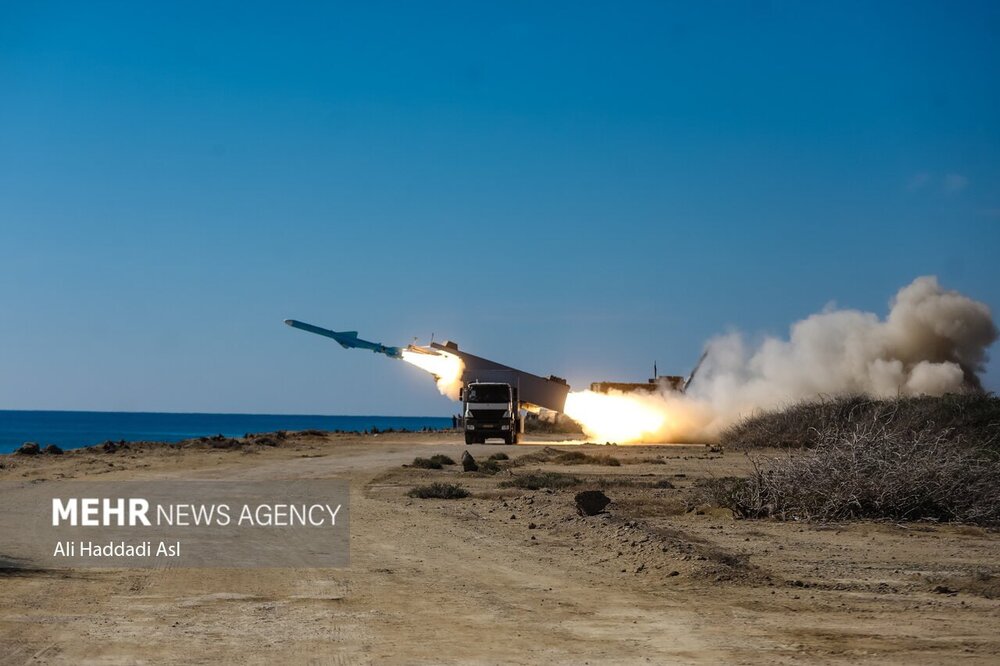Iran simulates attack on Israeli naval base: Report

TEHRAN- An Israeli media outlet claimed that in the recent large-scale military drills conducted by the Iranian Army, a homegrown Iranian explosive-laden drone was utilized to target an alleged mock version of an Israeli Navy base.
The Iranian Army's combat drones conducted on Saturday close air support (CAS) operations and launched ground attacks during the major stage of the Zolfaqar 1401 joint drills.
Based on footage punished on the social media, the Hengam-class landing ship IRIS Lavan launched an Ababil suicide drone onto selected targets, dubbed the "simulated naval base" by Israeli media.
Israeli media cited open-source intelligence-gathering Twitter accounts, highlighting that the fake facility was created with a similar architectural plan to the Eilat Naval Base in the Red Sea coast city of the same name.
Mersad air defense system eliminates enemy drones
A mock hostile unmanned aerial vehicle was shot down by an indigenously-developed air defense system as it flew over a region where the Iranian Army was conducting extensive military exercises involving several divisions of its troops.
In a night operation during the drills late on Saturday, the radars of the medium-altitude surface-to-air Mersad (Ambush) missile system intercepted the airborne target on the third day of the joint drills known as Zolfaqar 1401, which are taking place in a region stretching from the country's southern ports and waterways to the northern tip of the Indian Ocean.
The system then launched a missile in collaboration with the Integrated Air Defense System of the Iranian Army, striking the spy drone as it flew at a distance of 150 kilometers and a height of 25,000 feet.
The transportable, adaptable, and tactical missile defense system Mersad was created by Iranian military experts.
It now has detecting range of 150-kilometer instead of just 100 kilometers. The system uses advanced technology, and enjoys excellent operating precision and continuity, and can lock on and kill targets at a distance of 40 kilometers.
After launching a missile, Mersad may shift positions in the same amount of time and can be launched in less than 7 minutes.
Additionally on Sunday, the Iranian Kilo-class Tareq attack submarine fired its first Miad torpedo at a predetermined naval target.
During the wargame, Qadir submarines also exploded a variety of naval targets using their own smart, fast-moving Valfajr torpedoes.
Aerial torpedoes were also thrown into the water by Sikorsky SH multi-mission helicopters of the Iranian Army, which advanced to the target and then obliterated it.
The torpedo's massively destructive payload allows it to sneak up on targets, destroy them, and sink large naval warships in a matter of seconds.
The quick pre-launch preparation time of Valfajr is a unique characteristic that significantly improves the tactical capabilities, performance, and quick response of the combat forces, whether they are warships or submarines.
Compared to other torpedoes, Valfajr has a greater range, more accuracy, and greater destructive capability.
The Zolfaqar 1401 exercises began late Thursday night and include infantry, armored and mechanized forces, surface, sub-surface, and floating boats, air defense systems, marine commandos, and strategic bombers.
The exercises, according to the drills' spokesperson, Brigadier General Alireza Sheikh, are intended to advance training and combat preparation as well as carry out some tactical and intelligence plans to enhance regional security.
He cited the use of local military gear and equipment as one of the war game's notable features.
The military drills' commander, Deputy Army Chief Rear Admiral Habibollah Sayyari, stated earlier on Thursday that the message they convey is that regional countries can maintain peace in their communities via cooperative efforts, rather than depending on outsiders.
Sayyari also said that Zolfaqar 1401 drills encompass locations north of the Indian Ocean as well as the Jask region, which is situated in southern Iran close to the Strait of Hormuz.
The Iranian Army's ground, air, and naval units take part in the joint exercises, which are undertaken to demonstrate the Iranian armed forces' self-confidence and fighting might, as well as their capacity to secure the region's long-term security and stability.
One of the key goals of the Zolfaqar 1401 drills, based on remarks made by Sayyari, is to improve Army units' abilities to conduct operations in unique situations and environments.
Drills warn off a reconnaissance plane striving to garner data
The military said that a drone was fired to scare away a spy plane attempting to approach Iranian military drills in the Persian Gulf.
Furthermore, it stated that the fire of a Karrar drone by air defense, during the drills, caused a P-8 manned intelligence aircraft belonging to extra-regional forces, which had attempted to lower altitude to gather more precise information from the exercise zone, to be compelled to depart the location.
Army commander says missions in Pacific boost morale
Major General Abdulrahim Mousavi, the Commander-in-chief of the Iranian Army, has praised an ongoing mission by the Army's 86th Naval Fleet in the Pacific Ocean as evidence of the country's independence and a stimulus to morale.
General Mousavi made the comments in a phone call with the commander of the Iranian mission in the Pacific on Sunday.
The top commander went on to say that the current Navy operation in the Pacific shows Iran's commitment to maintaining a presence in far-off areas and gives the Iranian armed troops a chance to gather maritime expertise.
The 86th Fleet's operation in the Pacific, the major general said, has been successful in flying the Iranian flag in far-off waters.
He noted that this is a further reinforcement to the confidence of the Iranian people as well as the country.
Leave a Comment